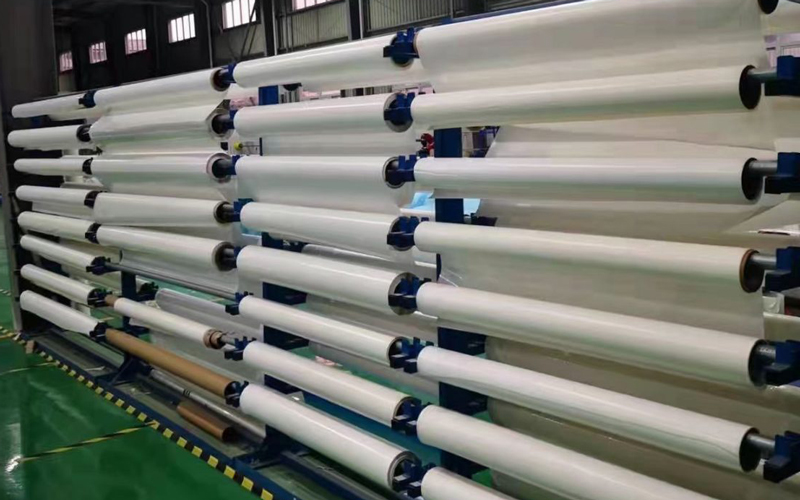Hot melt adhesive film is a solvent-free, pollution-free, environmentally friendly adhesive material widely used in textile, leather, electronics, automobile, home furnishing and other industries. According to its composition, hot melt adhesive film with different ingredients can be divided into many types, including TPU, PES, EVA, PA, PO and EAA. Hot melt adhesive films with different compositions have their own characteristics in melting point, color, elasticity, bonding performance and application fields. This article will introduce several common hot melt adhesive films in detail so that users can better choose suitable products.

Hot melt adhesive film with different ingredients
TPU hot melt adhesive film
TPU (thermoplastic polyurethane) hot melt adhesive film is the most widely used one in the market, and its main component is polyurethane. According to the melting point, TPU hot melt adhesive film can be divided into low melting point type (50-80℃), high melting point type (120℃) and ultra-high melting point type (145℃).
- Low melting point TPU hot melt adhesive film is white matte and inelastic, suitable for materials with low requirements for bonding strength.
- High melting point TPU hot melt adhesive film is transparent and elastic, suitable for fabrics, leather, sponges and other materials with high elasticity requirements.
- Ultra-high melting point TPU hot melt adhesive film has high elasticity and is suitable for high-end clothing, footwear and special industrial applications.
TPU hot melt adhesive film has excellent water washing resistance and is suitable for seamless clothing, footwear, automotive interior, electronic products and other industries.
PES hot melt adhesive film
The main component of PES (polyester) hot melt adhesive film is copolyester, with a melting point between 115-125℃ and a color that is generally white, translucent or milky white. PES hot melt adhesive film has no elasticity, but has strong bonding properties to materials such as polyester fabrics, polyester films, sponges, rubber and metals, and has excellent water washing resistance.
Due to its strong temperature resistance and chemical resistance, PES hot melt adhesive film is widely used in clothing, electronics, automobile and construction industries, especially for bonding needs under high temperature environments.
EVA hot melt adhesive film
EVA (vinyl acetate copolymer) hot melt adhesive film has a low melting point of about 70°C, is translucent in color, becomes transparent after use, and has a certain degree of elasticity.
The application range of EVA hot melt adhesive film is relatively narrow, and the bonding effect on most fabrics is average, but it has a good bonding effect on materials such as polypropylene, EVA foam, XPE, wood, paper, and some rubber. It is mainly used in home building materials and handicraft industries, such as wall cloth bonding, mounting technology, etc.
PA hot melt adhesive film
PA (polyamide) hot melt adhesive film has a melting point between 125-135°C, is transparent in color, inelastic, and has good bonding properties for various fabrics, sponges, films, rubber and other materials.
Although PA hot melt adhesive film has excellent bonding properties, it is less used in the market due to its high raw material cost and lack of elasticity. At present, PA hot melt adhesive film is still used in some specific high-end application fields, such as high-end clothing, special industrial gluing, etc.
PO hot melt adhesive film
The melting point of PO (polyolefin) hot melt adhesive film is between 95-105℃, transparent in color and inelastic. PO hot melt adhesive film has a low cost and can be used to bond materials such as fabrics, films, leather and metals, so it has a certain market share in industries such as embroidery trademarks, clothing, and footwear.
Due to its relatively low melting point, PO hot melt adhesive film is more suitable for products that do not require high temperature resistance, such as ordinary clothing labels, insole bonding and other applications.
EAA hot melt adhesive film
EAA (acetic acid acrylic acid copolymer) hot melt adhesive film has a wide melting point range, is white and translucent in color, and is inelastic. EAA hot melt adhesive film is mainly used for bonding fabrics and metal materials, but it is currently less used in the market. Due to its poor hydrolysis resistance, EAA hot melt adhesive film may have a problem of decreased adhesion when used in certain humid environments, so its scope of application is relatively limited.
Conclusion
Hot melt adhesive film with different ingredients have their own advantages in terms of bonding performance, melting point, elasticity and application fields:
- TPU hot melt adhesive film is suitable for textiles, leather, sponges, etc., has excellent water-washing resistance, and is the most widely used one.
- PES hot melt adhesive film is suitable for polyester fabrics, sponges, rubber, metals, etc., has excellent water-washing resistance, and is often used in high temperature environments.
- EVA hot melt adhesive film is suitable for EVA foam, wood, paper, etc., and is mainly used in home building materials and handicrafts.
- PA hot melt adhesive film is suitable for all kinds of fabrics, sponges, films, etc., with excellent bonding performance, but is less used due to its high cost.
- PO hot melt adhesive film is suitable for fabrics, films, leather, metals, has low cost, and is mainly used in embroidery trademarks and clothing industries.
- EAA hot melt adhesive film is suitable for fabrics and metal materials, but is less used in the market.
When selecting hot melt adhesive film, users should consider factors such as melting point, adhesive material, water washability and cost according to specific application requirements to ensure the best bonding effect. Welcome to contact Alster for price of the hot melt adhesive films.






